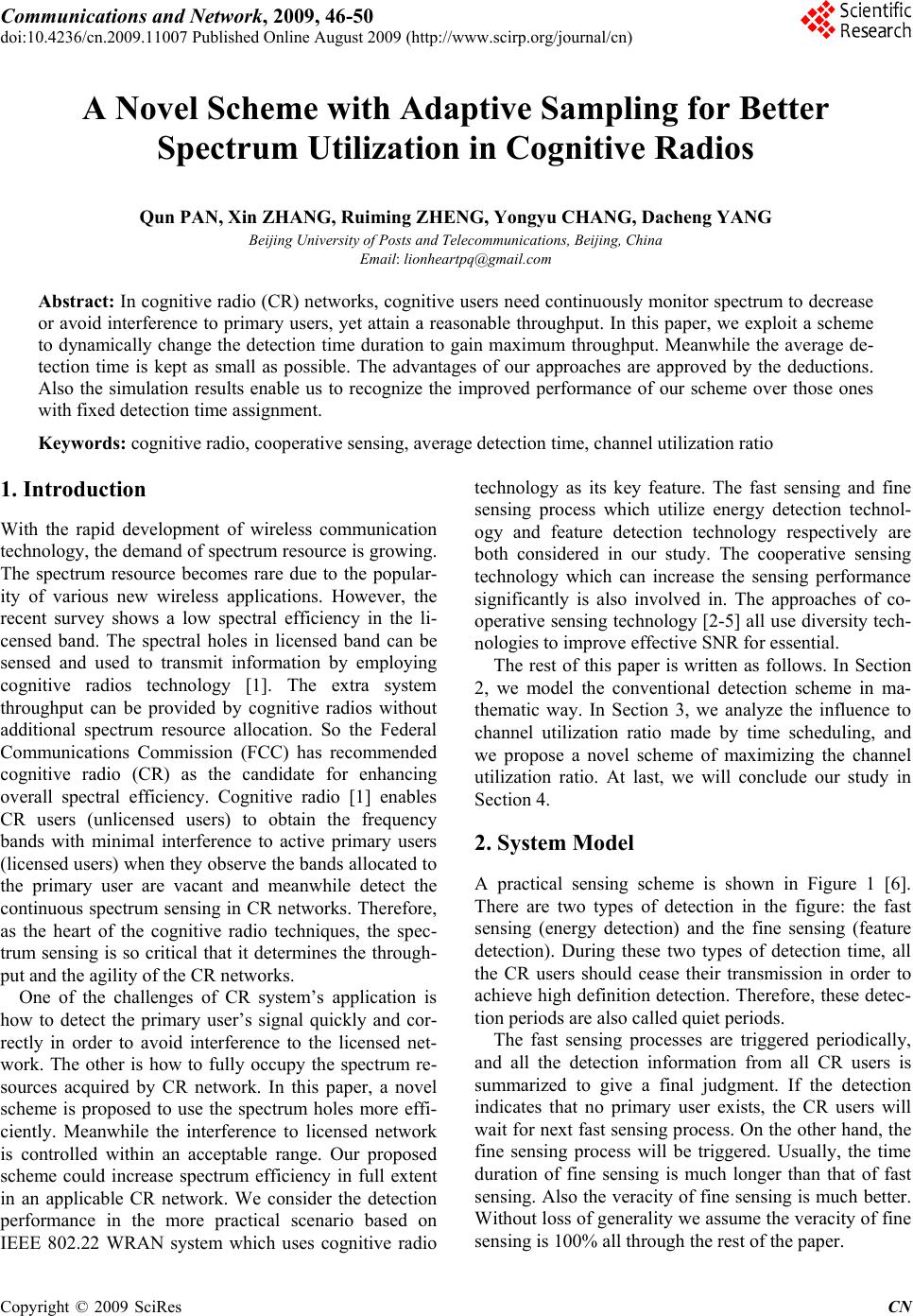
Communications and Network, 2009, 46-50
doi:10.4236/cn.2009.11007 Published Online August 2009 (http://www.scirp.org/journal/cn)
Copyright © 2009 SciRes CN
A Novel Scheme with Adaptive Sampling for Better
Spectrum Utilization in Cognitive Radios
Qun PAN, Xin ZHANG, Ruiming ZHENG, Yongyu CHANG, Dacheng YANG
Beijing University of Posts and Telecommunications, Beijing, China
Email: lionheartpq@gmail.com
Abstract: In cognitive radio (CR) networks, cognitive users need continuously monitor spectrum to decrease
or avoid interference to primary users, yet attain a reasonable throughput. In this paper, we exploit a scheme
to dynamically change the detection time duration to gain maximum throughput. Meanwhile the average de-
tection time is kept as small as possible. The advantages of our approaches are approved by the deductions.
Also the simulation results enable us to recognize the improved performance of our scheme over those ones
with fixed detection time assignment.
Keywords: cognitive radio, cooperative sensing, average detection time, channel utilization ratio
1. Introduction
With the rapid development of wireless communication
technology, the demand of spectrum resource is growing.
The spectrum resource becomes rare due to the popular-
ity of various new wireless applications. However, the
recent survey shows a low spectral efficiency in the li-
censed band. The spectral holes in licensed band can be
sensed and used to transmit information by employing
cognitive radios technology [1]. The extra system
throughput can be provided by cognitive radios without
additional spectrum resource allocation. So the Federal
Communications Commission (FCC) has recommended
cognitive radio (CR) as the candidate for enhancing
overall spectral efficiency. Cognitive radio [1] enables
CR users (unlicensed users) to obtain the frequency
bands with minimal interference to active primary users
(licensed users) when they observe the bands allocated to
the primary user are vacant and meanwhile detect the
continuous spectrum sensing in CR networks. Therefore,
as the heart of the cognitive radio techniques, the spec-
trum sensing is so critical that it determines the through-
put and the agility of the CR networks.
One of the challenges of CR system’s application is
how to detect the primary user’s signal quickly and cor-
rectly in order to avoid interference to the licensed net-
work. The other is how to fully occupy the spectrum re-
sources acquired by CR network. In this paper, a novel
scheme is proposed to use the spectrum holes more effi-
ciently. Meanwhile the interference to licensed network
is controlled within an acceptable range. Our proposed
scheme could increase spectrum efficiency in full extent
in an applicable CR network. We consider the detection
performance in the more practical scenario based on
IEEE 802.22 WRAN system which uses cognitive radio
technology as its key feature. The fast sensing and fine
sensing process which utilize energy detection technol-
ogy and feature detection technology respectively are
both considered in our study. The cooperative sensing
technology which can increase the sensing performance
significantly is also involved in. The approaches of co-
operative sensing technology [2-5] all use diversity tech-
nologies to improve effective SNR for essential.
The rest of this paper is written as follows. In Section
2, we model the conventional detection scheme in ma-
thematic way. In Section 3, we analyze the influence to
channel utilization ratio made by time scheduling, and
we propose a novel scheme of maximizing the channel
utilization ratio. At last, we will conclude our study in
Section 4.
2. System Model
A practical sensing scheme is shown in Figure 1 [6].
There are two types of detection in the figure: the fast
sensing (energy detection) and the fine sensing (feature
detection). During these two types of detection time, all
the CR users should cease their transmission in order to
achieve high definition detection. Therefore, these detec-
tion periods are also called quiet periods.
The fast sensing processes are triggered periodically,
and all the detection information from all CR users is
summarized to give a final judgment. If the detection
indicates that no primary user exists, the CR users will
wait for next fast sensing process. On the other hand, the
fine sensing process will be triggered. Usually, the time
duration of fine sensing is much longer than that of fast
sensing. Also the veracity of fine sensing is much better.
Without loss of generality we assume the veracity of fine
sensing is 100% all through the rest of the paper.